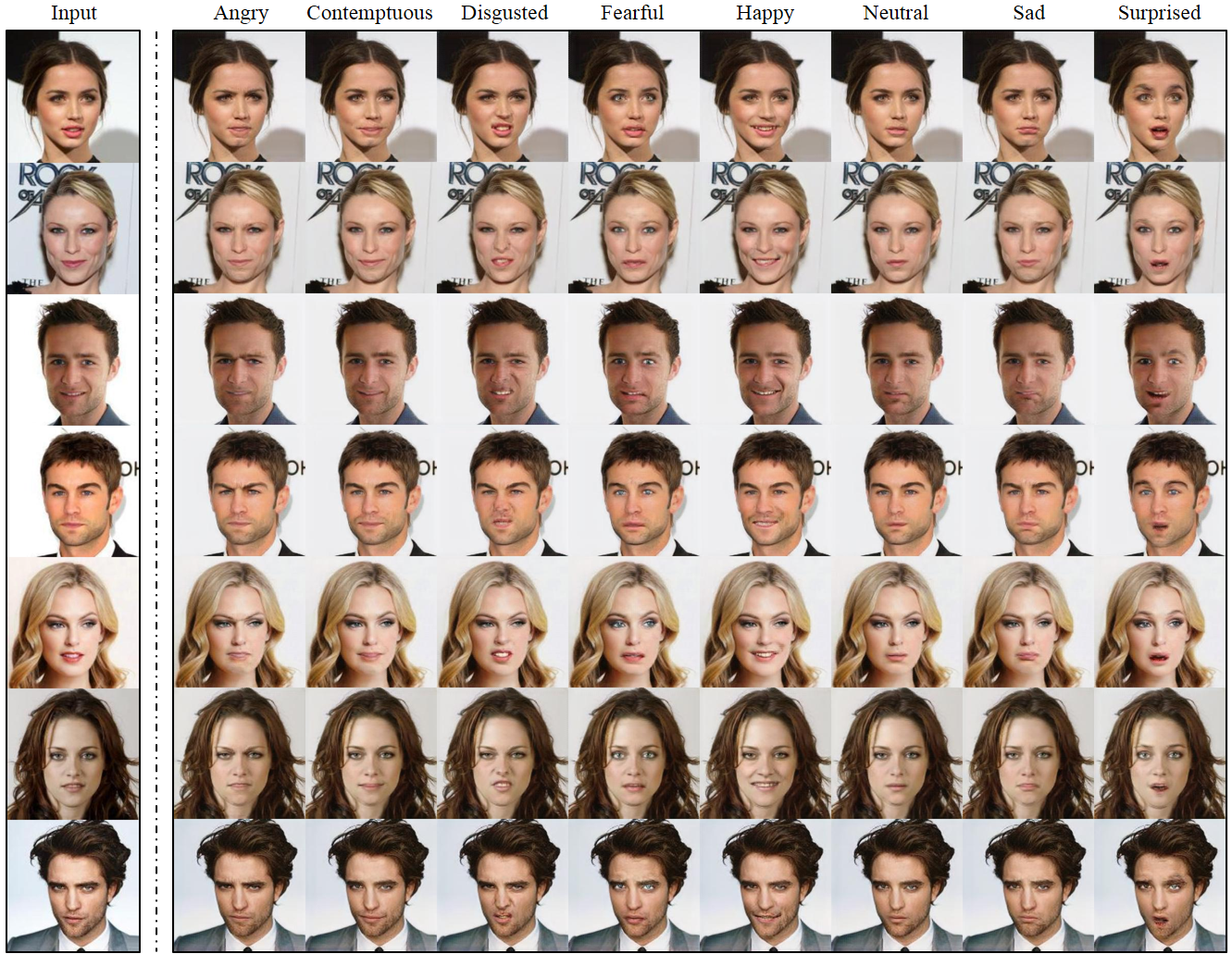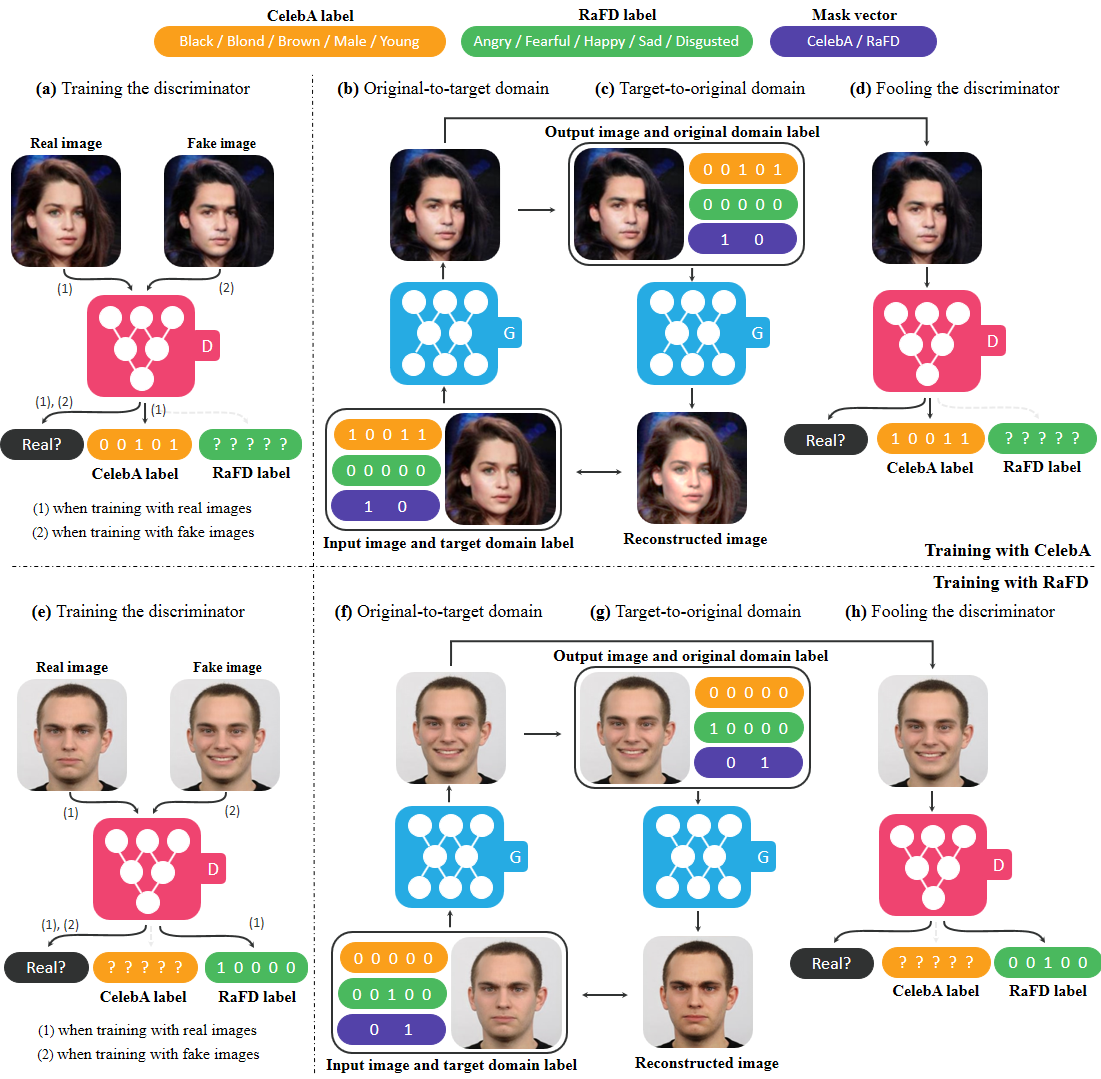PyTorch implementation of StarGAN: Unified Generative Adversarial Networks for Multi-Domain Image-to-Image Translation. StarGAN can flexibly translate an input image to any desired target domain using only a single generator and a discriminator.
Yunjey Choi, Minje Choi, Munyoung Kim, Jung-Woo Ha, Sung Kim, and Jaegul Choo
Korea Universitiy, Clova AI Research (NAVER), The College of New Jersey, HKUST
The images are generated by StarGAN trained on the CelebA dataset.
The images are generated by StarGAN trained on the RaFD dataset.
The images are generated by StarGAN trained on both the CelebA and RaFD dataset.
Overview of StarGAN, consisting of two modules, a discriminator D and a generator G. (a) D learns to distinguish between real and fake images and classify the real images to its corresponding domain. (b) G takes in as input both the image and target domain label and generates an fake image. The target domain label is spatially replicated and concatenated with the input image. (c) G tries to reconstruct the original image from the fake image given the original domain label. (d) G tries to generate images indistinguishable from real images and classifiable as target domain by D.
Overview of StarGAN when training with both CelebA and RaFD. (a) ~ (d) shows the training process using CelebA, and (e) ~ (h) shows the training process using RaFD. (a), (e) The discriminator D learns to distinguish between real and fake images and minimize the classification error only for the known label. (b), (c), (f), (g) When the mask vector (purple) is [1, 0], the generator G learns to focus on the CelebA label (yellow) and ignore the RaFD label (green) to perform image-to-image translation, and vice versa when the mask vector is [0, 1]. (d), (h) G tries to generate images that are both indistinguishable from real images and classifiable by D as belonging to the target domain.
- Python 3.5+
- PyTorch 0.2.0
- TensorFlow 1.3+ (optional for tensorboard)
$ git clone https://github.com/yunjey/StarGAN.git
$ cd StarGAN/$ bash download.shBecause RaFD is not a public dataset, you must first request access to the dataset from the Radboud Faces Database website. Then, you need to create the folder structure as decribed here.
$ python main.py --mode='train' --dataset='CelebA' --c_dim=5 --image_size=128 \
--sample_path='stargan_celebA/samples' --log_path='stargan_celebA/logs' \
--model_save_path='stargan_celebA/models' --result_path='stargan_celebA/results'$ python main.py --mode='train' --dataset='RaFD' --c_dim=8 --image_size=128 \
--num_epochs=200 --num_epochs_decay=100 --sample_step=200 --model_save_step=200 \
--sample_path='stargan_rafd/samples' --log_path='stargan_rafd/logs' \
--model_save_path='stargan_rafd/models' --result_path='stargan_rafd/results'$ python main.py --mode='train' --dataset='Both' --image_size=256 --num_iters=200000 --num_iters_decay=100000 \
--sample_path='stargan_both/samples' --log_path='stargan_both/logs' \
--model_save_path='stargan_both/models' --result_path='stargan_both/results'$ python main.py --mode='test' --dataset='CelebA' --c_dim=5 --image_size=128 --test_model='20_1000' \
--sample_path='stargan_celebA/samples' --log_path='stargan_celebA/logs' \
--model_save_path='stargan_celebA/models' --result_path='stargan_celebA/results'$ python main.py --mode='test' --dataset='RaFD' --c_dim=8 --image_size=128 \
--test_model='200_200' --rafd_image_path='data/RaFD/test' \
--sample_path='stargan_rafd/samples' --log_path='stargan_rafd/logs' \
--model_save_path='stargan_rafd/models' --result_path='stargan_rafd/results'$ python main.py --mode='test' --dataset='Both' --image_size=256 --test_model='200000' \
--sample_path='stargan_both/samples' --log_path='stargan_both/logs' \
--model_save_path='stargan_both/models' --result_path='stargan_both/results'
If this work is useful for your research, please cite our arXiv paper.
@article{choi2017stargan,
title = {StarGAN: Unified Generative Adversarial Networks for Multi-Domain Image-to-Image Translation},
author = {Choi, Yunjey and Choi, Minje and Kim, Munyoung and Ha, Jung-Woo and Kim, Sunghun and Choo, Jaegul},
journal= {arXiv preprint arXiv:1711.09020},
Year = {2017}
}
This work was mainly done while the first author did a research internship at Clova AI Research, NAVER (CLAIR). We also thank all the researchers at CLAIR, especially Donghyun Kwak, for insightful discussions.






